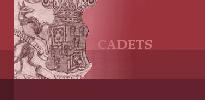|
The Family of Winton
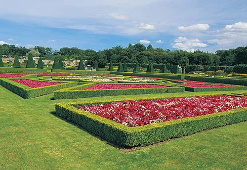 
In the early history of the Seton
family, the lands of Winton were granted by Royal Charter by King to Philip de
Setoune. Philip succeeded to
Seher, his father and got a charter from
King William the Lion, in 1169, confirming to him certain lands, which remained
in possession of his descendants for more than five hundred years. It is one of
the oldest Scottish charters in existence, and is mentioned with enthusiasm by
the learned Cosmo Innes (Scotland in the Middle Ages, p. 20), who says: "I could
not give you a better specimen of one of those ancient simple conveyances than a
charter of William the Lion, a grant to the ancient family of Seton. It conveys
three great baronies, confers all baronial privileges, fixes the reddendo at one
knight's service, expresses the formal authentication of a goodly array of
witnesses, and is comprised in seven short lines. The original is in possession
of the Earl of Eglinton and Winton. From Philip stems the family of Winton,
and in the style of the times, his son took as their family name that of their estate. Sources: "The History of the House of Seytoun to the Year MDLIX", Sir Richard Maitland of Lethington, Knight, with the
Continuation, by Alexander Viscount Kingston, to MDCLXXXVII. Printed at Glasgow,
MDCCCXXIX. "A History of the Family of Seton during Eight Centuries" George
Seton, Advocate, M.A. Oxon., etc. Two vols. Edinburgh, 1896"An Old Family"
Monsignor Seton, Call Number: R929.2 S495
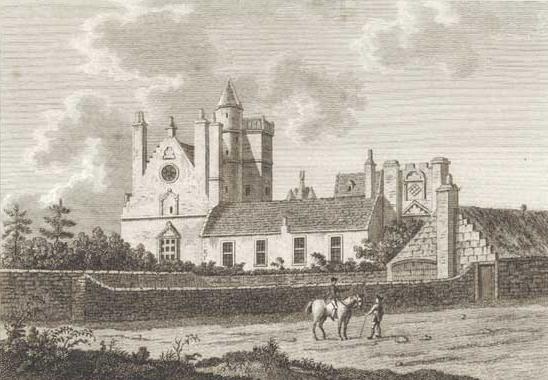 In the year 1347, Lady Margaret
Seton was forcibly abducted by a neighboring baron named Alan de Winton, a distant
kinsman of her own and a cadet of the Seton family. Andrew Wyntoun relates the
case in his Orygynale Cronykil of Scotland, saying: "Dat yhere Alene de Wyntoun
tuk the yhoung Lady Setoun and weddit hyr than till hys wyf." This outrage
caused a bloody contest in Lothian; on which occasion, says Fordun, a hundred
ploughs were laid aside from labor.
A romantic incident of this affair--the opposition springing, perhaps, from
selfish motives on the part of her guardian--is that when Margaret was rescued
and Alan confronted with the Seton family, she was handed a ring and a dagger,
with permission to give him either Love or Death. She gave him the ring, and
they were happy ever afterward. Alan de Winton assumed his wife's name,
and died in the Holy Land, leaving besides a daughter Christian de Seton who
became Countess of Dunbar and March, three sons: 1st Sir William Seton,
his successor and 1st Lord Seton; 2nd Alexander Seton who married Jean
Halyburton, daughter of Sir Thomas Halyburton of Dirleton (recorded by Alexander
Nisbet); and Henry who retained his father's name and inherited Wrychthouses (Wrightshouses,
Edinburgh).
One of the oldest stones of this mansion bears the Seton's arms. In the year 1347, Lady Margaret
Seton was forcibly abducted by a neighboring baron named Alan de Winton, a distant
kinsman of her own and a cadet of the Seton family. Andrew Wyntoun relates the
case in his Orygynale Cronykil of Scotland, saying: "Dat yhere Alene de Wyntoun
tuk the yhoung Lady Setoun and weddit hyr than till hys wyf." This outrage
caused a bloody contest in Lothian; on which occasion, says Fordun, a hundred
ploughs were laid aside from labor.
A romantic incident of this affair--the opposition springing, perhaps, from
selfish motives on the part of her guardian--is that when Margaret was rescued
and Alan confronted with the Seton family, she was handed a ring and a dagger,
with permission to give him either Love or Death. She gave him the ring, and
they were happy ever afterward. Alan de Winton assumed his wife's name,
and died in the Holy Land, leaving besides a daughter Christian de Seton who
became Countess of Dunbar and March, three sons: 1st Sir William Seton,
his successor and 1st Lord Seton; 2nd Alexander Seton who married Jean
Halyburton, daughter of Sir Thomas Halyburton of Dirleton (recorded by Alexander
Nisbet); and Henry who retained his father's name and inherited Wrychthouses (Wrightshouses,
Edinburgh).
One of the oldest stones of this mansion bears the Seton's arms.
Henry de
Winton married Amy Brown of Coalston and continued the family name of Winton.
Henry was one of the heroes of Otterburn, August 19, 1388. Friossart calls
him :The Seigneur de Venton" (Wintoun, Francisque Michel). Sources: "The
History of the House of Seytoun to the Year MDLIX", Sir Richard Maitland of
Lethington, Knight, with the Continuation, by Alexander Viscount Kingston, to
MDCLXXXVII. Printed at Glasgow, MDCCCXXIX. "A History of the Family of Seton
during Eight Centuries" George Seton, Advocate, M.A. Oxon., etc. Two vols.
Edinburgh, 1896 "An Old Family" Monsignor Seton, Call Number: R929.2 S495.
From Henry de Winton was descended the famous Scottish chronicler, Andrew
Wyntoun, who is credited as being Scotlands first historian.
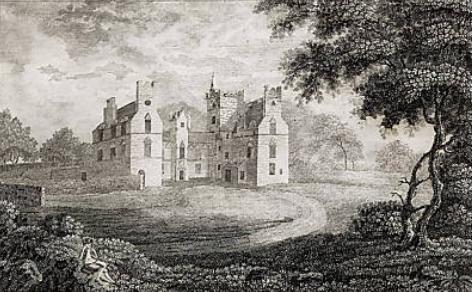
From the Winton's of Wrychthouses
stems the Scottish family of Winton, and the estate of Wrychthouses was to
remain with them until it was sold to the Napier family. The estate is
listed in
Blaeu's Atlas of Scotland, 1654
compiled by David
Buchanan, 1595-1652.
The lands of the
estate of Wrightshouses are found between the Water of Leith and the North Esk
there are very many houses and castles of nobles worthy of mention. First
between the Water of Leith and the Braid Burn, starting from the foot of the
Pentland Hills and continuing the descent to the north as far as the Forth, are
Swanston, Comiston, Craiglockhart, Craighouse, Braid, Plewlands, Bruntsfield,
Grange, Sciennes, Wrightshouses, Merchiston, Priestfield, Dalry, Coates, Drum,
Broughton, Pilrig, Restalrig, and Duddingston.
The Wrychtishousis (Wrightshouses) estate, in Edinburgh, lay
to the west of the Biggar Road just to the south of Tollcross at the beginning
of the district now known as Bruntsfield. The name is recorded in a charter
dated 1382, but the oldest inscription noted in the walls of the mansion dated
from the Seton-Winton's tenure, anno 1376. The estate was acquired by a William Napier sometime between 1390
and 1406. The origin of the name is not certain, it could be "houses of
wrights or carpenters" but considering its rural location in the 14th
century, nearly two miles outside the city walls, it seems unlikely. It is more
likely to have been named after an owner called Wright.
From the "Antiquities of Scotland", the
mansion-castle was noted as:
THE WRYTE's HOUSES.
THE Wryte's Houses stand a small distance south-west of the town
of Edinburgh, in a suburb called Portsborough. Their
denomination is vulgarly, but erroneously, said to have
originated from their having been the residence of certain
Wrights or Carpenters, employed in cutting down and working the
oaks and other timber growing on the Borough Muir ; but
Maitland, who mentions this, says they were houses belonging to
the Laird of Wryte. The western wing of this building, according
to him, is the most ancient part of the edifice, having on it an
inscription bearing date anno 1316. The
wing at the eastern side was, as is related, built in the reign
of king Robert III. and the centre building, connecting them,
was erected in the reign of king James VI. but Arnot says this
house was built for the reception of a mistress of king James
IV. This he seems to affirm of the whole building.
IN 1788, when this View was taken, they had been just repaired,
and deformed with a daubing of lime or whitewash, and had,
besides, been otherwise much injured in their appearance, by the
modernizing of the windows of the centre building, which before
agreed with the style of the wings.
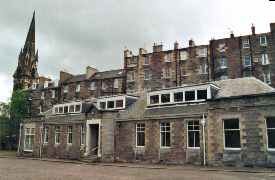
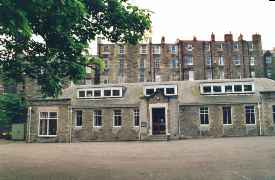
All
that remains of the old castle or mansion of the Winton's line
of Wrychthouses.
From the "Carpenter Gothic".
Gillespies Hospital, built on the site of the picturesque ancient mansion of
Wrighthouses, demolished to make room for it by the Trustees of James Gillespie,
snuff maker. Built 1806.
Used as soldiers quarters during the War.
click to read:
Alexander Winton, Motorcar Manufacturer
The Scottish chronicler, born (as we know from the
internal evidence of his writings) in the reign of David II, about the middle of
the fourteenth century. He was related to Alan of Wyntoun, who married the
heiress of Seton, and is now represented by the Earl of Eglinton and Winton. He
became a canon-regular of the priory of St. Andrews, and before 1395 was
appointed prior of the ancient monastery of Lochleven, in Kinross-schire, which
was a subject house of St. Andrews for upwards of four hundred years (see
LOCHLEVEN). Innes, in his "Critical Essay" (1729), pointed out that the register
of the priory of St. Andrews contained several acts or public instruments of
Wyntoun, as prior of Lochleven, from 1395 to 1413; but there is no evidence as
to how long he continued in office after the latter year, or as to the date of
his death. It was at the request of Sir John de Wemyss (ancestor of the Earls of
Wemyss), whom he mentions as one of his intimate friends, that Wyntoun undertook
to write his "Orygynale Cronykil of Scotland", so entitled, as he himself
explains, not because it was his own composition, but because it begins at the
beginning of things, namely with the creation of
angels. How long the compilation of the work took is
uncertain, but the fact that Robert, Duke of Albany, is mentioned in it as dead
proves that it was finished some time after September, 1420. The author, while
engaged in the latter part of it, reckoned himself already an old man, as
appears from his prologue to the ninth book, so that it is not probable that he
lived long after its completion. The variations in the manuscripts show that it
was frequently revised and corrected, in all probability by Wyntoun's own hand.
No printed edition of the Chronicle appeared until 1795, when
it was edited from the Royal manuscript in the British Museum, with a valuable
critical introduction, by David Macpherson. Nearly one- third of the original
was, however, omitted, and this was restored by Laing in his edition published
in 1872, in the "Historians of Scotland" series. Laing describes the eleven
manuscripts of the Chronicle known to exist, and the Scottish Text Society has
since printed a new edition from the Cottonian and Wemyss manuscripts, with the
variants of the other texts. A considerable portion of the Chronicle, it must be
noted, is the work of an unknown author, who sent it to Wyntoun, and it was
incorporated by him into his own narrative. Both are written in the same
easy-flowing, octosyllabic rhyming verse, and the work has therefore value from
a poetical as well as from an historical standpoint. Andrew Lang credits Wyntoun
with "a trace of the critical spirit, displayed in his wrestlings with feigned
genealogies"; but Æneas Mackay does him more justice in pointing out that he
understands the importance of chronology, and is, for the age in which he wrote,
wonderfully accurate as to dates. His work has thus real value as the first
attempt at scientific history writing in Scotland, and philologically it is not
less important as having been written in the Scots vernacular, and not (like
nearly all the works of contemporary men of learning) in a dead language.
Regarded as a poet, Wyntoun can hardly take high rank, certainly not equal rank
to his predecessor Barbour, the father of Scottish poetry. His narrative, in
truth, though written in rhyme is mostly prosaic in style; but some of his
descriptions are vivid, and touched with the true spirit of poetry.
"In Wyntown’s
Chronicle," says Mr Macpherson, "the historian may find, what, for want of more
ancient records, which have long ago perished, we must now consider as the
original accounts of many transactions, and also many events related from his
own knowledge or the reports of eye-witnesses. His faithful adherence to his
authorities appears from comparing his accounts with unquestionable vouchers,
such as the Federa Angliae, and the existing remains of the ‘Register of
the Priory of St Andrews,’ that venerable monument of ancient Scottish history
and antiquities, generally coeval with the facts recorded in it, whence he has
given large extracts almost literally translated." His character as an historian
is in a great measure common to the other historical writers of his age, who
generally admitted into their works the absurdity of tradition along with
authentic narrative, and often without any mark of discrimination, esteeming it
a sufficient standard of historic fidelity to narrate nothing but what they
found written by others before them. Indeed, it may be considered fortunate that
they adopted this method of compilation, for through it we are presented with
many genuine transcripts from ancient authorities, of which their extracts are
the only existing remains. In Wyntown’s work, for example, we have nearly three
hundred lines of Barbour, in a more genuine state than in any manuscript of
Barbour’s own work, and we have also preserved a little elegiac song on the
death of Alexander III., which must be nearly ninety years older than Barbour’s
work. Of Barbour and other writers, Wyntown speaks in a generous and respectful
manner, [He even avows his incompetency to write equal to Barbour, as in the
following lines:-- The Stewartis originale, The Archdekyne has tretyd hal, In
metre fayre mare wertwsly, Than I can thynk be my study, &c. –Cronykil, B. viii.
c. 7. v. 143.] and the same liberality of sentiment is displayed by him
regarding the enemies of his country, whose gallantry he takes frequent occasion
to praise. Considering the paucity of books in Scotland at the time, Wyntown’s
learning and resources were by no means contemptible. He quotes, among the
ancient authors, Aristotle, Galen, Palaephatus, Josephus, Cicero, Livy, Justin,
Solinus, and Valerius Maximus, and also mentions Homer, Virgil, Horace, Ovid,
Statius, Boethius, Dionysius, Cato, Dares Phrygius, Origen, Augustin, Jerome, &c
Wyntown’s
Chronicle being in rhyme, he ranks among the poets of Scotland and he is in
point of time the third of the few early ones whose works we possess, Thomas the
Rhymer and Barbour being his only extant predecessors. His work is entirely
composed of couplets, and these generally of eight syllables, though lines even
of ten and others of six syllables frequently occur. "Perhaps," says Mr Ellis,
"the noblest modern versifier who should undertake to enumerate in metre the
years of our Lord in only one century, would feel some respect for the ingenuity
with which Wyntown has contrived to vary his rhymes throughout such a formidable
chronological series as he ventured to encounter. His genius is certainly
inferior to that of his predecessor Barbour; but at least his versification is
easy, his language pure, and his style often animated."
He
wrote it in the Scottish tongue, was an older contemporary of Walter Bower. He
died an old man soon after 1420. Of him, as of the other contemporary
chroniclers, we know little except that he was head of St. Serf’s priory in
Lochleven, and a canon regular of St. Andrews, which, in 1413, became the site
of the first university founded in Scotland. The name of his work, The
Orygynale Cronykil, only means that he went back to the beginning of things,
as do the others. Wyntoun surpasses them only in beginning with a book on the
history of angels. Naturally, the early part is derived mostly from the Bible,
and The Cronykil has no historical value except for Scotland, and for
Scotland only from Malcolm Canmore onwards, its value increasing as the author
approaches his own time. For Robert the Bruce, he not only refers to Barbour but
quotes nearly three hundred lines of The Bruce verbatim—thus being the
earliest, and a very valuable, authority for Barbour’s text. in the last two
books, he also incorporates a long chronicle, the author of which he says he did
not know. From the historical point of view, these chroniclers altogether
perverted the early chronology of Scottish affairs. The iron of Edward I had
sunk deep into the Scottish soul, and it was necessary, at all costs, to show
that Scotland had a list of kings extending backwards far beyond anything that
England could boast. This it was easy to achieve by making the Scottish and
Pictish dynasties successive instead of contemporary, and patching awkward flaws
by creating a few more kings when necessary. That the Scots might not be charged
with being usurpers, it was necessary to allege that they were in Scotland
before the Picts. History was thus turned upside down.
Apart from the
national interests which were involved, the controversy was exactly like that
which raged between Oxford and Cambridge in the sixteenth century as to the date
of their foundations, and it led to the same tampering with evidence. Wyntoun
has no claims to the name of poet. He is a chronicler, and would himself have
been surprised to be found in the company of the “makaris.”
The original scheme was for seven
books, but the work was, later, extended to nine. Wyntoun would not have
been the child of his age and training did not the early part of his history
contain many marvels. We hear how Gedell-Glaiss, the son of Sir Newill, came out
of Scythia and married Scota, Pharaoh’s daughter. Being, naturally, unpopular
with the Egyptian nobility, he then emigrated to Spain and founded the race
which, in later days, appeared in Ireland and Scotland. It is interesting to
learn that Wyntoun identified Gaelic and Basque, part of the Scottish stock
remaining behind in Spain.
And Simon Brek it was that first brought the Coronation
Stone from Spain to Ireland. The exact date before the Christian era is given
for all these important events. When Wyntoun arrives at the Christian
dispensation and the era of the saints, it is only natural that he should dwell
with satisfaction on the achievements of St. Serf, to whom his own priory was
dedicated. St. Serf was the “kyngis sone off Kanaan,” who, leaving the kingdom
to his younger brother, passed through Alexandria, Constantinople and Rome.
Hence, after he had been seven years pope, his guiding angel conducted him
through France. He then took ship, arrived in the Firth of Forth and was advised
by St. Adamnan to pass into Fife. Ultimately, after difficulties with the
Pictish king, he founded a church at Culross, and then passed to the “Inche of
Lowchlewyn.” That he should raise the dead and cast out devils was to be
expected. A thief stole his pet lamb and ate it. Taxed with the crime by the
saint he denied it, but was speedily convicted, for “the schype thar bletyt in
hys wayme.” 52
Wyntoun tells, not without sympathy, the story of that “Duk of Frissis,” who,
with one foot already in the baptismal font, halted to enquire whether more of
his kindred were in hell or heaven. The bishop of those days could have but one
answer, whereupon the duke said
With all his
credulity, Wyntoun, in the later part of his chronicle, is a most valuable
source for the history of his country. To him and to Fordun we are indebted for
most of our knowledge of early Scotland, since little documentary evidence of
that period survived the wreck that was wrought by Edward I.
|
|
|
Withe thai
he cheyssit 53
hym to duel, |
|
And said
he dowtyt for to be |
|
Reprewit
wnkynde gif that he |
|
Sulde
withedraw hym in to deide 54 |
|
Fra his
kyn til ane wncouthe leide, 55 |
|
Qwhar he
was nwrist and bred wp withe, |
|
Qwhar
neuir nane was of his kyn, |
|
Aulde na [char]onge,
mare na myn, |
|
That neuir
was blenkyt withe that blayme. |
|
“[Abrenuncio] for thi that schayme,” |
|
He said,
and of the fant he tuk |
|
His fute,
and hail he thar forsuyk |
|
Cristyndome euir for to ta, 56 |
|
For til
his freyndis he walde ga |
|
Withe
thaim stedfastly to duell |
|
Euirmare
in the pyne of hel. 57 |
|
Good churchman as Wyntoun is, he is not slow to tell of
wickedness in high places and duly relates the story of pope Joan, with the
curious addition
|
|
|
Scho was
Inglis of nacion |
|
Richt
willy of condicion |
|
A burges
douchtyr and his ayre |
|
Prewe,
pleyssande and richt fayr; |
|
Thai
callit hir fadyr Hob of Lyne. 58 |
|
In this book (chap. 18) he also tells the most famous of all
his stories—Macbeth and the weird sisters, and the interview between Malcolm and
Macduff. But Wyntoun renders Macbeth more justice than other writers,
|
|
|
[char]it
in his tyme thar wes plente |
|
Off gold
and siluer, catall and fee. 59 |
|
He wes in
iustice rycht lauchfull, |
|
And till
his liegis rycht awfull. 60 |
|
Birnam wood comes to Dunsinane, and Macbeth, fleeing
across the Mounth, is slain “in to the wod of Lumfanane.” 61
With all his credulity, Wyntoun, in the later part of his chronicle, is a most
valuable source for the history of his country. To him and to Fordun we are
indebted for most of our knowledge of early Scotland, since little documentary
evidence of that period survived the wreck that was wrought by Edward I.
There are various
manuscripts of Wyntown’s work, more or less perfect, still extant. The one in
the British
Museum is the oldest and the best; and after it rank, in antiquity and
correctness, the manuscripts belonging to the Cotton Library and to the
Advocates’ Library at Edinburgh.
|
 |
